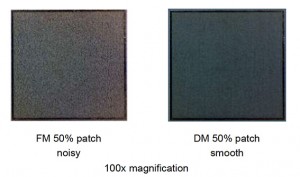AM, FM or XM and now DM ‘beautiful’ screening?
 The area of halftone screens, their types, technologies and ruling have long been associated with improving print quality. It was only 20 years ago when 200 dpi (dots per inch) AM screening was considered as a fine screen and quite difficult to print.
The area of halftone screens, their types, technologies and ruling have long been associated with improving print quality. It was only 20 years ago when 200 dpi (dots per inch) AM screening was considered as a fine screen and quite difficult to print.
I guess I do not have to explain here what AM, FM and XM screening are in detail, but lets look at their use and adoption over the years?
175/200 dpi AM screens are now the defacto standard for offset litho printing on coated papers.
FM or stochastic screens have been around since the early 1990’s, but were not used by many until the advent of computer to plate devices. The very small dot size used by these screens, around 20 micron, made their use in a film to plate workflow near uncontrollable.
The first versions of FM screens produced very good image quality, reduced the chance of moiré, but produced very ‘noisy’ or grainy tints, which many found unacceptable. As computer to plate systems were introduced in the late 1990’s and become common in the 2000’s, what could be called FM v 2 were introduced. The control of the dots to plate was no longer an issue and the new versions reduced some of the issues with tints, but not all!
In an effect to overcome these remaining problems the workflow vendors released a number of what where first called hybrid screening types; now referred to as XM screens (Cross Modulated). These attempted to minimise the issues with FM screens by using a combination of FM and AM screening technologies at differing screen percentage values. These screens, such Agfa’s Sublima and Screen’s Spekta 2 have proved popular and successful over the last few years.
So we come to DM screening? Where has this come from? DM or Digital Modulation screening is a development by Hamillroad Software’s Andy Cave that I have been following with interest for the last couple of years. Some have called it FM v3, but Andy Cave will say it is much more then that!
Best to quote Andy Cave on how and why it differs:
‘Utilising the immense computing power available with modern computers, DM screening is so named because it digitally modulates each and every pixel that it produces, rather than repeating a fixed pattern of dots (as in AM screening) or randomly marking a pixel (as in FM screening). The result is an unprecedented quality of screening, which is easy to plate and print using any CtP device (including violet, UV and thermal).’
So how does it look?Beauitiful! It shows detailed and smooth images and it seems to solve all the issues with noise and grain in tints, indeed tints and text made from CMYK look smoother then FM or AM screens.
Other claims for the DM screening include reduced dot gain, quicker make readies, reduced ink consumption, there are some figures for these areas quoted in the sample book, and there are other reports on the savings that FM screens can acreive on workflow vendors web sites, but more information in these areas would be useful.
What I have seen is an interesting book of printed samples produced by Hamillroad Software of its ‘Auraia’ DM screening. Auraia is the Greek word for beautiful.
This is an interesting set of ‘Real World’ printed samples, from a letterhead to an advertisement to a brochure. In fact a range of print that a typical small commercial offset printer would produce, rather then the ‘high end’ brochures and posters used to promote this area, that often avoid areas that would show up screening issues!
Auraia DM screening is at present only available on systems with Harlequin RIPs v8 and above, but as a technology it seems to solve many of the issues currently seen in FM screens. It is out in the market now and in use at number of printers around the world, including web offset, sheet fed litho and newspapers.
I hope that sooner rather then later it becomes available in some of the Adobe PDF Print Engine based workflows, so making it available to a wider audience.
http://www.hamillroad.com/main/products/auraiascreening.htm
Twitter
- Paul Sherfield who runs the consultancy is well known in the printing and pre-media industry as having considerable knowledge on digital workflows, with a special expertise on the business reasoning behind such systems.
He has installed some of the most successful digital pre-press and pre media systems in the UK. For 2 years he worked on a number of medium term projects before starting the consultancy in July 2000. Before this he was a partner in what became one of the leading pre-press/printing companies in London.
He is active in a number of industry groups including the BPIF Technical Standards Committee, ISO TC 130 printing standards committees and is chair of the BPIF steering group for ISO 12647/2 UK certification, He is a regular speaker at seminars and conferences.



